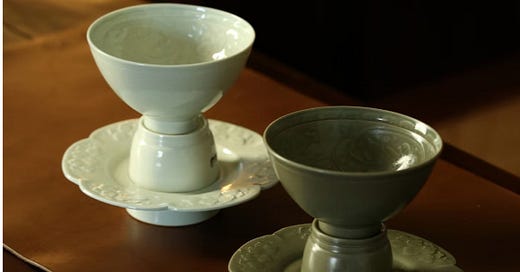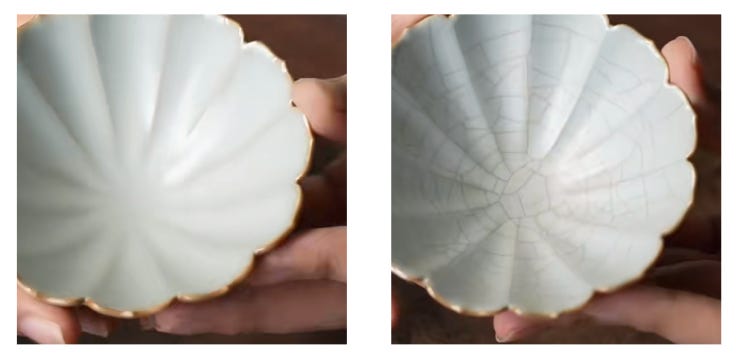China’s past and future, a celadon cup from the Song dynasty
On unearthing the past to find who we are
Hello friends,
This time, I wrote about China, and it felt so good.
Since childhood, I've straddled the two continents. And always, I have an ever-present desire to bridge the two cultures—China and the US are like my mom and dad.
Here’s to the first post on China.
Would love to hear from you. Say hi by responding to this email directly or commenting on this post :)
I followed my parents to the US at the age of ten. Since then, I have flown back to Beijing seventeen times.
I like sharing my observations about China with my American friends:
"In the US, we’re looking into the future," I would tell my stories. "Education is centered around innovation, the next big thing, and the emphasis on trailblazing and carving our path. Whereas in China, education starts by looking at the past. When we wrote essays in elementary school, I pulled lines from ancient poetry and sǎnwén. The teacher underlined the phrases we ‘borrowed’ from the old masters. In the US, this is plagiarism; in China this pushed that A to an A+."
Each year I went home, I noticed increments of change. One year, instead of mobbing to get on the bus, people lined up. In 2008, four new subway lines popped out of nowhere in preparation for the Olympics. The next thing I knew, a lady at wo-er-ma (Walmart) stared at me as if I were from some small village when I inquired about the pricing of a box of chocolate cookies: “You just place it in your cart, and it’ll show up on WeChat.”
Every change is a surprise. And with every change, China is moving forward.
Left: Beijing subway as I remember growing up. Middle: Beijing subway in 2008. Right: Beijing subway today. (source)
In 2023, I noticed yet another change—the design innovation of a cup.
As a design nerd, I am the type who walks into every home goods store or crafts market I encounter, in Copenhagen, Tel Aviv, Nairobi. One cup has a minimalist form with “pixel-perfect” proportion, one features speckled clay and earthy glazes, while another has hand-painted geometric motifs. I claim to recognize every design pattern of a cup.
This time, I walked into a teaware store at a mall in Wangfujing and picked up a teacup: a thin-walled vessel with a translucent celadon glaze.1 It has relief patterns of lotus flowers and peony scrolls, and its flowy decorative curves exude simple elegance and subtle sophistication. I stared at it for a long time. It looks Chinese and yet, I’ve never seen this design style before.
With respect to Asian teaware, a familiar style that comes to mind is that of the Japanese—muted in color, marked by subtle asymmetry and deliberate imperfection of the wabi-sabi. Yet a design of Chinese origin, my own ethnic identity, I can barely recognize. It felt as if my education was missing critical cultural pieces that I was not aware of.
I researched its history. It’s from the Song Dynasty (960-1279 CE). Apparently, Song was the pinnacle of Chinese civilization2: the literati, the elegant gatherings, and ceramics with supreme aesthetic harmony. Song's tea ceremony diǎnchá 宋代点茶, a complex practice that is mostly lost today, is the origin of the Japanese tea ceremony. The Song was so engrossed in its cultural advancement that it had forgotten to build its military forces to the extent that it was susceptible to Mongol invasion. And that's how the Song dynasty collapsed, amid poetry 诗词, fine wine 美酒, and tunes of gǔzhēng 琴声3.
And this piece of history came back in the form of a cup.
My select cup adventures:
Top left: July 19, 2018 @Copenhagen, Top right: Oct 20, 2023 @Vail, Colorado
Center: Feb 4, 2024 @Nairobi
Bottom left: July 31, 2018 @Tel Aviv, Bottom right: June 28, 2018 @Helsinki
Various cup styles of the category of Song ceramics known as rǔyáo 汝窑, (source)
For a long time, China rejected its past. The reminiscences of the cultural revolution (1966) carried forth in the air I grew up in. Moving forward meant moving fast towards the foreign and the modern. And in the process, China threw away its rich history. If the historic city walls and all the hutongs of Beiping4 were kept, arguably it would have been the largest historic town in the world, surpassing Rome and Paris.
In the mindless pursuit of the foreign, China went through a phase (around 2014) of creating what Xi deemed as "ugly architecture"—weird skyscrapers protruding in the skyline: including "Giant Underpants" (CCTV Headquarters in Beijing), the coin-shaped Guangzhou Circle, and the replica of the Eiffel Tower.
And yet, the culture of respecting and holding onto the past is an invisible force.
In 2021, Xi banned those ugly buildings (source). Instead of innovation for innovation’s sake, architecture is more beautiful when it takes inspiration from the past and makes an effort to respect the history and the surrounding landscape. When the roofline, adapted with modern materials yet expresses historical forms, blends in with the nearby sweeping eaves and cylindrical tiles of sìhéyuàn, to me, it blends with our hearts as Chinese.
In recent years, the past has not only resurfaced but also been valued and given spotlight. Now, the more the country grows up, innovates, and looks forward, the tighter its connection grows with its history.
China’s “ugly architecture”:
Top left: Even though it’s beautifully designed by Rem Koolhaas and Ole Scheeren of OMA, we call this landmark the “Giant Underpants”. CCTV Headquarters in Beijing 央视“大裤衩”
Top right: Coin-shaped Guangzhou Circle 广州圆大厦“铜钱大厦”
Below the coin: A building of báijiǔ. Wuliangye Yibin Building, Sichuan 五粮液大楼
Center: Tianzi Hotel, Hebei 河北“福禄寿”天子大酒店
Bottom left: The combination of the Temple of Heaven and the Capitol Hill building @Shijiazhuang, Hebei Province
Bottom right: A replica of the Eiffel Tower in Tianducheng
Vernacular architecture that takes inspiration from traditional Chinese cultural elements:
Top left: Chengdu Chongming Bamboo Craft Village: roof forms inspired by traditional Sichuan architecture 成都崇明竹工艺村,源于一首中国传统诗歌,描述了房屋与其乡村林环境之间的理想关系 (source)
Top right: Xu Wei Art Museum: incorporates Ming Dynasty scholarly garden elements, balanced relationship between the building and the surrounding landscape 徐渭艺术馆 (source)
Middle: Boxinyu Neighborhood Community Center: large-sloped roofs draw inspiration from the Jingchu regional architecture 泊心域社区邻里中心,大坡屋顶建筑意向源于对荆楚文化的回溯 (source)
Bottom: Hangzhou Buddhist Cultural Exchange Center: modern interpretation of Buddhist temple architecture, with historic temple roof designs and incorporation of traditional Buddhist spatial concepts 杭州佛教文化交流中心 (source)
The past is an inspiration in the designs of individual creatives. China, a leader in manufacturing, made building product prototypes widely accessible. A young designer in China can easily sketch out a design, work with a manufacturer, and have the prototype shipped across the country for a humble shipping fee of 20 yuan (USD $2.74) and make their vision a reality. Artists across the country started to integrate historical and cultural elements into modern product design.5
Through this creative manufacturing freedom, I found that celadon cup.
As China modernized, I felt an inevitable pull from the country and the people to seek the past, to rediscover what was lost, and to refind our roots. The past becomes a powerful foundation that allows one to sprint fast forward. This celadon cup is a reminder of who we used to be, and who we will be.
A friend spoke of this analogy: a monkey holds onto one branch as it prepares to swing onto the other. To move forward, one has to have a firm grip on its past.
The more China leaps forward, the more it embraces its past.
As for me, the older I get, the more Chinese I feel.
Living in the US through my formative years and adulthood, I’ve come to embrace American culture. And yet, as I navigate through life, I’ve developed a greater interest and appreciation for my history and language, coupled with a growing sense of pride for the place that I come from.
I continue to spend my summers at home. With each visit, I hold onto this intimacy with my roots, with China. With each visit, I become more fascinated by a past of which I am only scratching the surface. Each experience fueled unexpected learning and growth.
Somehow, having a past gives me strength. It helps me orient, serving as a compass for what's ahead.
—
One last thing, in rǔyáo 汝窑 ceramics, crackle patterns form as one drinks tea (known as kāipiàn 开片). The appearance of the crackles is said to be closely tied to the heart of the one who drinks the tea.
They’re like wrinkles on the skin or lines on the palm, documenting our history.
开片汝窑 (source)
Thank you friends from Write of Passage and Essay Club for the feedback, the ideas, and the edits: Benjamin Setor (
), Leanna, CansaFis Foote (), Becky Isjwara (), Matthew Beebe (), Cam Houser (), Maksim Pecherskiy (), and Charlie Becker ().I first came across this word at the Met, and the Met used to be where we saw China’s past more than in China.
I learned this from the book Founder's Notes by JiQi.
A traditional string instrument that all educated women in ancient China must know to play.












“The past becomes a powerful foundation that allows one to sprint fast forward.” What a great line. In your monkey analogy, it made me also picture how you need to swing backward to gain the momentum to propel forward. A great perspective.
I have always felt this in the US, that so many of us have a desire for a history we don’t know. Where our ancestors came from is a guess to many past a couple hundred years. My friends from Europe always jest at how Americans like to tell you what countries their ancestors are from when THEY didn’t actually grow up there, but I think it stems largely from what you’ve so well articulated: the subconscious knowing that the past is a part of us, and a feeling of lack that comes from only looking towards the future.
Also, I love your comments on the tea cups history and hope there’s an article in your future that will share more on that subject :)
...really really really cool...was so great to read this and hear you talk about it as well...the art, history and the culture are so fascinating...i hope some day to visit and see all the various pieces of the country...and i am excited to see and read more about what you have to share on it...thanks so much for this...